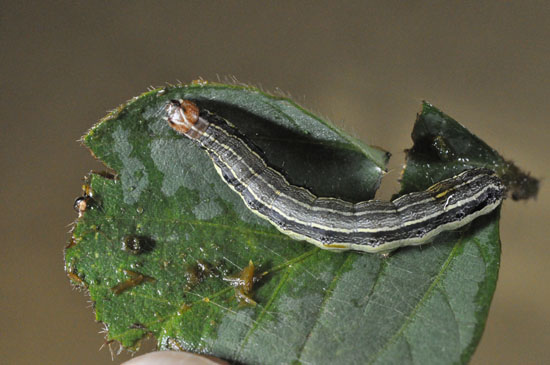Fall armyworm captures at all-time high
Fall armyworm captures at all-time high

Captures of fall armyworm moths in Western Kentucky are at a record high.
A total of 675 moths were captured Sept. 13 in the integrated pest management traps at the University of Kentucky Research and Education Center in Princeton. This surpassed the previous high of 549 collected Aug. 16 at the center. Fall armyworm moth captures remain low at the UK IPM traps located in Lexington.
“This will not be a distinct generation, as some of the worms from the previous large moth flight are still in fields,” said Doug Johnson, extension entomologist with the UK College of Agriculture. “Worms from this flight will begin appearing in one to two weeks.”
Each year, fall armyworm moths migrate to Kentucky from the South and begin laying eggs. Larvae hatch within three to five days. Fall armyworms are active beginning in mid-summer and are around until the first killing frost.
The pest varies in color, though the grass-feeding type tends to be green. The fall armyworm has three yellow stripes down its back. The middle stripe is usually darker, and the ones on each side are wavy and yellow-red blotched. Fall armyworms have dark heads with a light-colored, inverted "Y" mark on front.
Producers currently scouting for this pest will see numbers begin to drop off as worms from the first flight die off, but they will pick back up again as the second flight produces caterpillars, Johnson said.
Fall armyworms prefer to lay their eggs in and feed on grasses, but they will move to other crops including row crops, alfalfa, tomatoes, cucumbers and tobacco if no grass is available. This was and may continue be the case this year in areas of drought-stricken Western Kentucky.
“I would check grasses that are in good condition first, because they will likely have the most eggs,” Johnson said. “Young wheat plants and late-maturing soybeans are going to be susceptible too. In the first flight, there were worm infestations at the edge of some soybean fields. The worms migrated to these fields after they destroyed neighboring pastures.”
Their feeding will cause small, dark brown patches to appear in pastures. Producers may mistake these patches for rock or hardpan. In addition, worms may hide underneath field debris or in soil cracks. As the worms continue to feed and their population increases, these patches will become larger. Once they destroy an area, they will move on to the next available food source.
Insecticides will provide the best control for fall armyworms when they are 0.75 inches long or smaller. Each crop has a different threshold level before treatment with insecticides is warranted. More information on these levels and insecticides is available at local offices of the UK Cooperative Extension Service.
While fall armyworm is a pest of cattle and horse pastures, it should not affect the animals. It should not be confused with the eastern tent caterpillar that causes mare reproductive loss syndrome. Fall armyworms appear in Kentucky only in late summer and fall. Eastern tent caterpillars appear in the spring.
Entomology Ag Equine Programs Extension Weather

